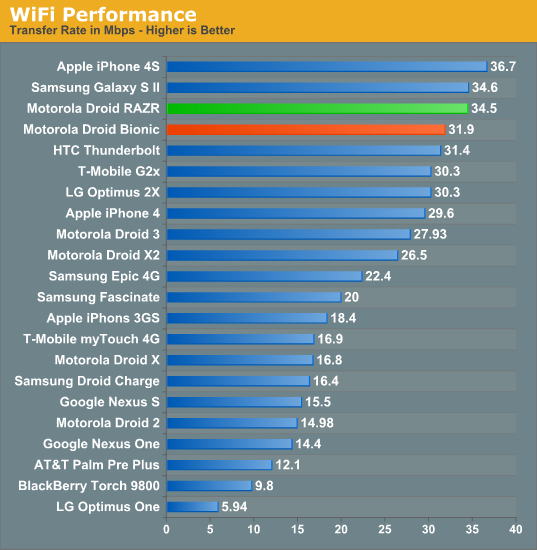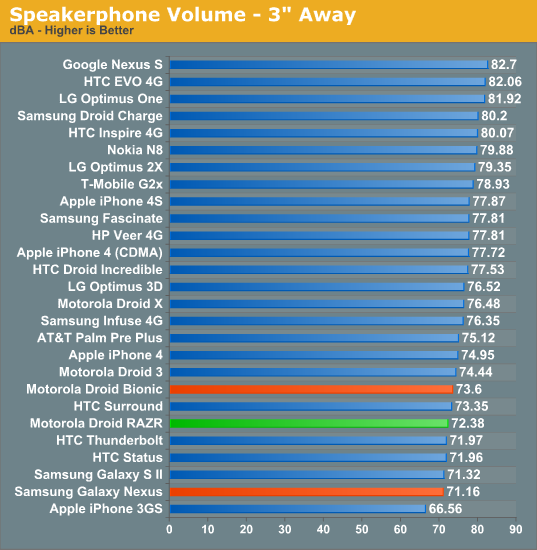Motorola Droid RAZR Review - A Better Clad Bionic
by Brian Klug on December 16, 2011 2:01 AM EST- Posted in
- Smartphones
- Droid
- LTE
- 4G
- Motorola
- Android
- Mobile
- Droid RAZR
- motorola droid RAZR
WiFi, GPS, Audio and Speakerphone
The RAZR uses a TI Wilink 7 series WL1285 combo chip for Bluetooth and WiFi, which is the same situation as the Bionic, unsurprisingly. WiFi is limited to 2.4 GHz and single spatial stream 802.11n, and I saw the RAZR negotiate a 65 Mbps (long guard interval) physical rate with my 20 MHz 802.11n wireless network. I found that range on the RAZR is totally on par with other smartphones I’ve used. Though the visualization at the top seems to be rather conservative with showing bars, if you go view the actual RSSI for WiFi (inside ##4636## and Wireless Information) you’ll see things are just fine. Bluetooth is 4.0 LE + EDR which is the latest bleeding edge.

Throughput on WiFi is pretty decent and just a tad faster than the Bionic. It’s possible the subtle software differences between the two account for this difference in throughput.
WiFi Hotspot
I had some issues with the RAZR’s WiFi hotspot that I didn’t encounter with the Bionic. Specifically, when using the hotspot with WPA2 enabled, clients would only be able to attach occasionally for a short period, or not at all. This initially posed lots of frustration when trying to do our WiFi hotspot battery life test, however disabling encryption entirely and running a public AP resulted in no instability.
You still can attach a maximum of 5 clients if you pay the extra fare to Verizon to enable tethering (which the device does check to see is provisioned), and on the whole this works well, just only with security set to open in my experience.
GPS
To the best of my knowledge, the RAZR is using the GPS system onboard MDM6600 and not from the TI Wilink 7 series combo chip. It’s a bit hard to nail down for sure, but I was able to confirm on the Bionic and it seems reasonable that the same applies here.
Like we’re used to seeing from that system, GPS locks are super fast even indoors and don’t pause or stutter at all. I didn’t have any issues with GPS and used the RAZR a few times with Google navigation without any hitch.
Audio + Speakerphone
First up in the audio department is speakerphone loudness, which we’ve been measuring for a while now using a USB sound level data logger while placing a test call to the local ASOS. The RAZR is on the quiet side which isn’t incredibly surprising considering the placement and constraints on the size of its acoustic chamber.

The other part of audio is of course call quality, and the RAZR isn’t different at all subjectively from the other Motorola phones on Verizon I’ve reviewed recently. As a reminder all calls go over 1x voice, and by default almost every device uses the EVRC coder, though you can change this to 13k in the programming menu and perceive a slight change in call quality. Noise cancellation features likewise remain the same, again courtesy of the three microphones onboard the RAZR.
The last important audio quality metric is what the device sounds like when playing back music. The Bionic used an ST-E 3.1 CPAC combo power management IC and audio codec, and the RAZR uses an ST-E 3.2 CPCAP. I’m embarrassed to admit it, but I only recently discovered how to change (read: disable) the DSP that Motorola has enabled on the RAZR by default (and ostensibly many other of their devices that have crossed my desk). Because I use Google Music, I rarely venture into the first party Music application, and it’s inside here that the settings lurk for DSP, which are by default enabled.
The background whine that I complained about on the Bionic is reduced but still faintly perceptible with sensitive IEMs on the RAZR. Though it is still present, it’s no longer as fatiguing and irritating as it was on the Bionic. I’m not sure whether that’s more a function of ST-E’s 3.2 (as opposed to 3.1) or something else, but it’s much better.
If you’re interested, I also ran a run of RMAA using an ASUS Xonar Xense sound card and line-in on the RAZR, Nexus S with VoodooSound, and a GSM Galaxy Nexus for comparison. The RAZR with all of the equalizer and DSP settings turned off actually isn’t bad at all, and though I’m not an expert at reading RMAA’s tea leaves, it has good noise figures and frequency response, and though noise takes off at the lower frequencies as our own Chris H. pointed out this less than ideal behavior is only 7% of the spectrum.










76 Comments
View All Comments
mfenn - Friday, December 16, 2011 - link
Dunno how many times I have to say this, but etc. is short for "et cetera". Putting more than one period in it is just plain wrong.jordanclock - Sunday, December 18, 2011 - link
Actually, when finishing a sentence with etc. it is correct to put a second period afterward, as the first one is to indicate an abbreviation and the second is to indicate the end of the sentence. It is acceptable to use just one period, but it is not incorrect to use two.BabelHuber - Friday, December 16, 2011 - link
A question to the Anandtech guys:Why don't you ever lose a word about rSAp (remote SIM Access Profile)?
I regularily use my phones in my car, where I want to use the built-in antenna when connecting my phone via bluetooth.
Connecting via Handsfree is really a PITA: The speech quality is bad and the phone's battery is stressed.
Hence for three years now I use rSAP, first in my Audi A5 and now in my BMW 5er (via the Snap-in adapter SAP from BMW).
I still have my good old Nokia X6, this one does rSAp very well. Android, OTOH, does not support rSAP (neither does iOS), but AFAIK e.g. Samsung added rSAP-capabilities to the Galaxy line.
I know that testing rSAP is not easy because of the different systems the various Auto makers use, but it would even be interresting if you could test it at least a little bit (e.g. checking if the Adress Book synchronization works or if one has to use the SIM card itself).
A phone without rSAP is useless for me, but perhaps I am part of a small minority, who knows.
Have you had any thoughts on rSAP?
Conficio - Friday, December 16, 2011 - link
Where are you located? I have not heard about that tech.But sounds very interesting. Especially as there is a big debate going on in the US about driving and using the phone.
BabelHuber - Friday, December 16, 2011 - link
I'm located in Germany, but I would think that rSAP is a global tech.It supported by VW/ Audi, Mercedes and BMW. For BMW, you need the 'Snap-in-adapter SAP', though.
With rSAP, the phone is put to standby-mode, since the phone itself is in the car. The car gets the SIM-card-information via bluetooth and also reads the address book, then you use its built-in phone.
It's a cool technology, the speech quality is very good, since the antenna of the car is used. Also there is almost no drag on the phone's battery, since it doesn't do anything at all.
The downside is that you cannot stream music from your phone to the car's stereo, you also can't use E-Mail with rSAP.
For me this is OK, though, I don't want to receive mails while driving and the car's stereo is fed by a USB-harddisk attached to it.
introiboad - Tuesday, December 20, 2011 - link
There is no technical reason for you not to be able to stream music even when using RSAP. They are 2 different profiles, RSAP and A2DP, and should be able to run in parallel. It's a limitation imposed by the car manufacturer, not by the spec.JonnyDough - Saturday, December 17, 2011 - link
Its not really a debate. Using a cell while driving should be illegal. When you're operating a vehicle that can take someone's life in a 30mph crash then your eyes, hands, and mind should be focused on the task of driving. I learned that in driver's ed and I believe its still part of the test to get a driver's license. Driving is a privilege and so many of the younger generations today have such a sense of entitlement..cheetahfox - Saturday, December 17, 2011 - link
As someone who was nearly killed because the person that hit my car was changing the radio station; there will always be distractions in a car. If you feel that Cell phones should be illegal then you should also ban all radio's, gps, cd-players and ipods. Further you should also make all cars have a single seat. We can't let someone talking to you distract you. You should also have some way to measure if a car is being driven by someone that is sleepy. It's been shown over and over again the lack of sleep is worse that drunk driving. I propose a mandatory system of cameras that monitor the driver of a car and if they detect that the person in question is sleepy and not attentive enough that they slowly cut power to the car and force them to pull over for a 30 min nap.I am taking it to an extreme but if we should ban cell phones, we should really ban many other things. Things that we would never ban, like more than one person in a car. The problem isn't the device, it's the person using it. If the person driving is a distracted driver(for whatever reason) and they cause an accident it should be handled with existing laws.
introiboad - Tuesday, December 20, 2011 - link
Remote SIM access profile is part of the Bluetooth Specification, it's just one of the profiles defined by the Bluetooth SIG. Unfortunately, RSAP never took off in the same way that HFP (Handsfree Profile) which is the profile that nearly every other phone available uses when connecting to a car.One of the reasons may be that RSAP requires the car to come bundled with a GSM baseband/radio since it only obtains the SIM info from the phone and then uses it to place calls using its own. On the other hand HFP simply instructs the phone to place the call using the phone's own GSM radio and then transfers the sound to the car. So it's clearly cheaper to include in a car since the car manufacturer doesn't need to include a Bluetooth _and_ a GSM radio.
introiboad - Tuesday, December 20, 2011 - link
As far as I know, only Symbian and Bada phones implement RSAP.